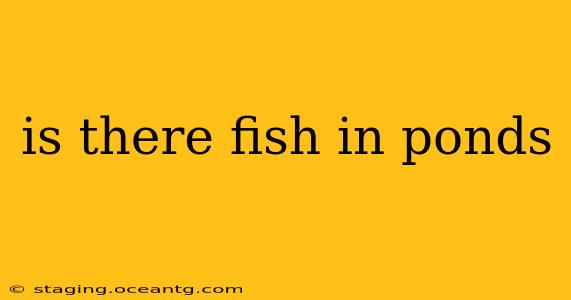The simple answer is: yes, there often is fish in ponds. However, the type and number of fish depend on several factors, making it more complex than a simple yes or no. This comprehensive guide will explore the fascinating world of pond fish, addressing common questions and misconceptions.
What Kinds of Fish Live in Ponds?
The types of fish found in a pond are highly variable and depend on several factors, including:
- Geographic location: Different regions have different native fish species. For example, a pond in the southeastern United States might have different species than a pond in the Pacific Northwest.
- Water quality: The clarity, temperature, and pH level of the water influence which fish can survive. Well-oxygenated, clean water supports a wider variety of fish.
- Pond size and depth: Larger, deeper ponds can support a greater diversity and number of fish. Smaller ponds might only support smaller populations of smaller species.
- Artificial stocking: Many ponds are stocked with fish by humans, either for recreational fishing or to control algae and insect populations. Common stocked species include goldfish, koi, and various types of trout (depending on the climate).
Some common pond fish include:
- Goldfish: Popular ornamental fish known for their hardiness and vibrant colors.
- Koi: Ornamental carp prized for their beauty and longevity.
- Bass: A predatory fish frequently found in larger ponds and lakes.
- Carp: A robust fish that can tolerate a wide range of water conditions.
- Sunfish: A smaller, colorful fish that serves as a food source for larger predators.
- Catfish: A bottom-feeding fish that can tolerate low-oxygen conditions.
What Determines the Number of Fish in a Pond?
The number of fish a pond can support is directly related to its carrying capacity. This is influenced by:
- Water volume: Larger ponds can support more fish.
- Oxygen levels: Insufficient oxygen can lead to fish kills.
- Food availability: The amount of algae, insects, and other food sources limits the number of fish that can thrive.
- Waste products: Excessive fish waste can pollute the water, impacting water quality and harming fish populations.
Are all ponds suitable for fish?
Not all ponds are ideal habitats for fish. Several factors influence suitability:
- Water depth: Ponds need to be deep enough to provide refuge from predators and maintain stable water temperatures. Shallower ponds are more susceptible to temperature fluctuations and are less suitable for many fish species.
- Water quality: Clean, well-oxygenated water is crucial. Ponds with excessive algae, pollution, or stagnant water are less hospitable to fish.
- Vegetation: A balance of aquatic plants is beneficial, providing oxygen, shelter, and food for fish. However, excessive plant growth can lead to oxygen depletion.
How do fish get into ponds?
Fish can enter ponds in several ways:
- Natural migration: Some fish can migrate from streams or rivers into connected ponds.
- Artificial stocking: Humans intentionally introduce fish into ponds.
- Accidental introduction: Fish can be introduced unintentionally through the movement of water, equipment, or contaminated plants.
What are the benefits of having fish in a pond?
Having fish in a pond can offer several benefits:
- Aesthetic value: Fish add beauty and visual interest to a pond.
- Pest control: Some fish can help control mosquito larvae and other unwanted insects.
- Recreational fishing: Stocked ponds can provide opportunities for recreational fishing.
Can I put any fish in my pond?
No, it's crucial to research which fish species are best suited for your specific pond environment. Introducing incompatible species can lead to ecological imbalances and harm the existing ecosystem. Consult with local experts or fisheries management agencies before introducing fish to your pond.
Understanding these factors will help ensure that your pond, if it's home to fish, is a thriving and healthy ecosystem. Remember that responsible pond management is key to maintaining a balanced and beautiful aquatic environment.
